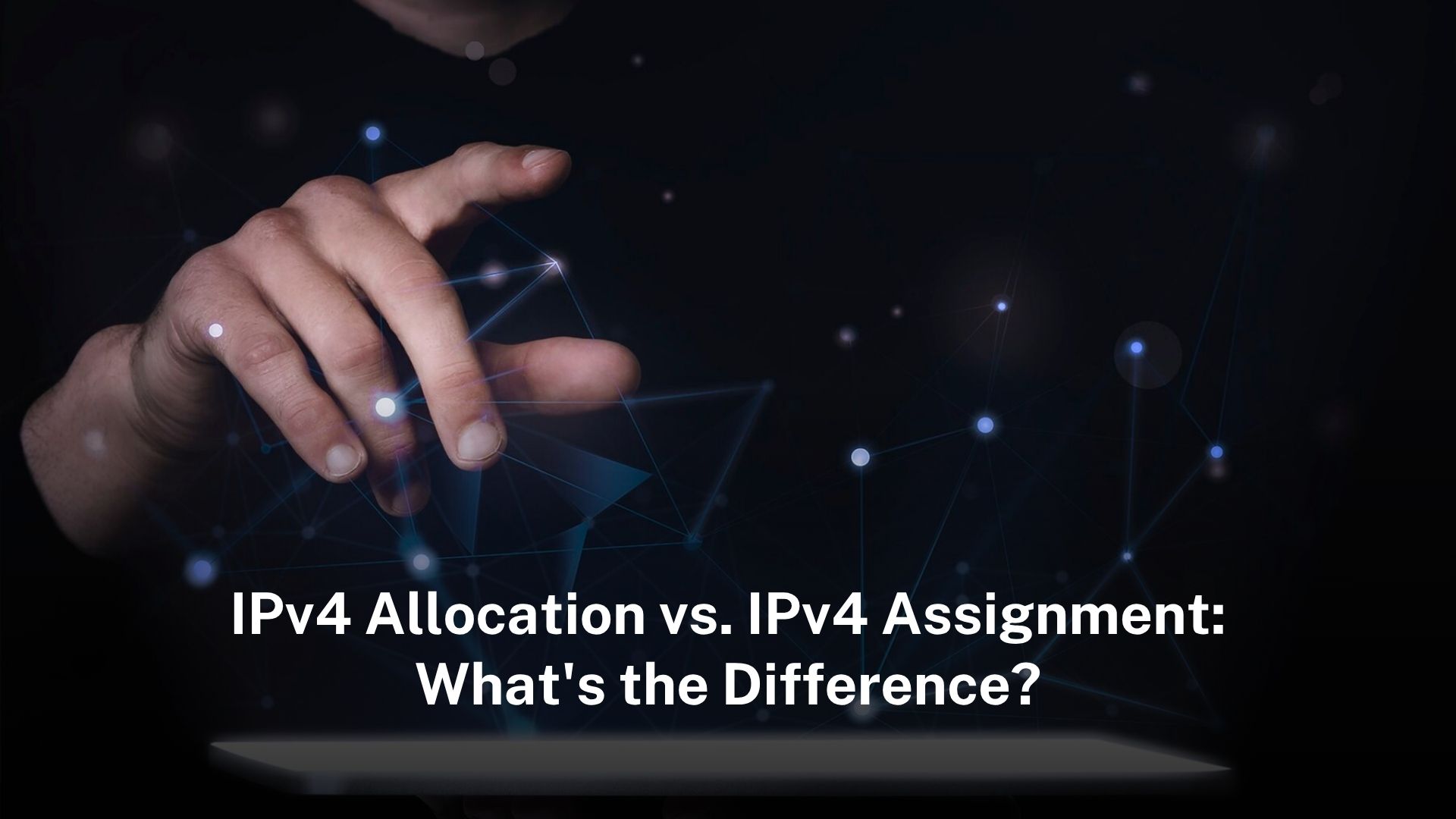Introduction: The IPv4 shortage crisis
The internet has completely run out of new IPv4 addresses. This problem became serious when IANA distributed its last blocks of IPv4 addresses in 2011. After that, regional internet registries like APNIC, ARIN, and RIPE NCC also used up their available addresses. There are exactly 4.3 billion possible IPv4 addresses and all of them are now being used by someone. This shortage creates major difficulties for cloud service providers and internet companies. They must now reuse old addresses or obtain them from other organizations. These solutions make network operations more complicated and expensive.
Table of Contents
ToggleThe IPv4 shortage continues growing worse each year. When IANA exhausted its supply in 2011, new rules limited address distribution to small blocks. By 2025, even these small blocks became extremely scarce. Organizations now participate in an active marketplace where IPv4 addresses are bought and rented. This limitation makes internet expansion challenging for everyone. Companies must carefully strategize how to utilize their existing address resources.
Understanding IPv4 allocation
IPv4 allocation refers to how large groups of addresses get distributed to regional organizations. Initially, IANA allocated massive address blocks to regional internet registries. These registries then allocated smaller blocks to internet service providers and large networks. This hierarchical system functioned well when addresses were abundant. The current situation requires completely different approaches. Regional registries now impose strict requirements before allocating addresses. They only distribute addresses to organizations with immediate, verified needs. Recipients must demonstrate concrete plans to adopt IPv6 technology. Most available addresses now come from private transfers rather than official allocations. The transfer process itself has become a specialized business requiring legal and technical expertise.
The allocation process continues evolving to conserve addresses. Current policies restrict allocations to small blocks like /22 networks. Applicants must provide detailed justification for their requests. They need to show progress in implementing IPv6 solutions. These measures prevent wasteful address usage but create administrative burdens. Many organizations find it easier to purchase addresses on the open market. Prices in this market consistently increase as scarcity worsens. Some companies generate revenue by selling unused address blocks. This commercial market represents a fundamental change in how internet resources get distributed. The system has transformed from technical distribution to economic trading. The secondary market for IPv4 addresses now involves brokers, auctions, and complex financial arrangements.
Understanding IPv4 assignment
IPv4 assignment describes how addresses get deployed to actual devices. Internet providers assign addresses to customer routers and modems. Cloud platforms assign addresses to virtual servers and services. Businesses assign addresses to their office equipment. This process used to be straightforward and unlimited. Today every single address requires careful consideration. Many internet providers implement CGNAT technology to share addresses among multiple users. While this conserves addresses, it causes technical problems. Certain applications like video conferencing perform poorly through CGNAT. Cloud services now impose additional charges for dedicated public IP addresses. The pricing models have become more complex to reflect address scarcity.
Organizations now maintain meticulous address assignment records. They actively monitor address utilization across their networks. Unused addresses get reclaimed and reassigned. Some companies sell excess addresses for significant profits. These assignment practices affect all internet users. CGNAT means numerous households share single IP addresses. Websites cannot distinguish between different users behind shared addresses. Some online games and applications malfunction under these conditions. These changes clearly demonstrate the increasing value of IPv4 addresses. The assignment process has become a critical business operation rather than simple technical configuration. Network administrators spend considerable time optimizing address usage to minimize costs.
Challenges for internet service providers
Internet providers face mounting difficulties due to IPv4 scarcity. They widely implement CGNAT solutions to stretch their address pools. While helpful, CGNAT introduces network complexity. Technical staff encounter more configuration issues and support requests. Certain applications fail to work properly through CGNAT. Video calling services often experience problems. File transfer protocols may not function correctly. Online games sometimes suffer performance issues. Network security becomes more challenging when multiple users share addresses. Identifying individual users for troubleshooting or legal requests grows complicated. The technical support costs increase as these issues multiply.
Providers increasingly participate in IPv4 transfer markets. Prices continue rising according to RIPE NCC’s 2024 reports. Traditional address allocation channels no longer meet demand. Most providers now lease or trade addresses commercially. They must accept market prices regardless of cost. This fundamentally changes their business operations. Network expansion requires careful financial planning. Every address acquisition decision carries significant cost implications. Providers must develop new strategies to manage their shrinking address resources. The IPv4 shortage has transformed basic network operations into complex financial planning exercises. Some providers have created entire departments dedicated to address management and acquisition.
Challenges for cloud service providers
Cloud providers confront major obstacles from IPv4 shortages. Their customers require public IP addresses for cloud servers and services. Previously, providers automatically assigned these addresses. Now public IPv4 addresses represent scarce commodities. Some providers strictly limit how many addresses each customer can obtain. Others implement premium pricing for additional addresses. These restrictions impact how businesses design their cloud infrastructure. Companies must modify their network architectures to accommodate limited address availability. The architectural changes often require significant engineering resources and planning.
Operational costs continue escalating for cloud providers. They actively purchase addresses through specialized brokers. Market prices show consistent upward trends. These increased costs get passed along to customers through higher service fees. New charges appear for previously standard features. The IPv4 shortage transforms how cloud services get priced and delivered. Every aspect of cloud computing feels the impact of address scarcity. Providers must balance customer needs against finite address resources. The situation creates tension between business growth and technical limitations. Some providers are experimenting with new technologies to reduce their IPv4 dependency while maintaining service quality.
Transitioning to IPv6 technology
More networks now support IPv6 alongside IPv4. An increasing number of devices and services work with IPv6. However, most existing systems still require IPv4 connectivity. Many providers operate dual-stack networks supporting both protocols. This approach maintains compatibility but increases complexity. The dual-stack approach requires additional configuration and maintenance efforts.
Special translation technologies bridge IPv4 and IPv6 networks. These systems allow different protocols to communicate. However, they introduce performance overheads. Network latency often increases. Management becomes more complicated. Unexpected issues arise more frequently. The complete transition from IPv4 to IPv6 will require many more years. During this extended transition period, IPv4 address scarcity will continue causing problems. The internet community faces a long, challenging migration process. Many organizations have established dedicated teams to manage their transition roadmaps and address the technical challenges.
Current IPv4 market conditions
IPv4 addresses now exist in fragmented distributions across countless organizations. Small address blocks frequently change ownership through transfers. These blocks constantly move between different network operators. Internet routers must maintain larger routing tables to track these fragments. This consumes additional memory and processing power. Network updates take longer to propagate. Overloaded routers create stability issues. Network engineers spend more time troubleshooting and optimizing systems. The routing infrastructure wasn’t designed to handle such fragmented address distribution at this scale.
The IPv4 marketplace remains highly dynamic. Address prices show steady increases as availability decreases. Trading activity intensifies each year. Regional policies continue evolving to address scarcity. Network operators must adapt while maintaining reliable services. The IPv4 shortage affects all internet participants. From multinational corporations to individual users, everyone experiences the consequences. This situation will persist until IPv6 completely replaces IPv4, a transition that will likely take another decade or more. The market dynamics continue to evolve as new players enter the address trading space and new financial instruments emerge.
Technical impacts of IPv4 shortage
Networks using many NAT layers become harder to manage. These layers start at home routers and continue in provider networks. Each layer changes device addresses. This creates more points where problems can happen. It makes port-forwarding difficult. Some applications need direct connections to work right. NAT breaks these connections. This affects games, video calls and file sharing. The additional complexity slows down network troubleshooting and maintenance. The cumulative effect of multiple NAT layers can significantly degrade user experience for certain applications.
When IPv4 blocks get split and moved, routing becomes complex. Many small address groups exist in different places. Routers must remember where each group goes. This fills router memory. Updates take longer. Long lists slow traffic movement. Recovery from problems becomes harder. The internet’s routing system was not designed for such fragmented address distribution. Engineers must constantly optimize systems to handle the growing routing tables. The routing table growth has become a major concern for network operators worldwide.
In cloud systems, virtual machines often use IPv6. The network must carry this traffic over IPv4. Special methods like 6to4 and Teredo wrap IPv6 data in IPv4 packets. This adds steps to data transfer. The extra steps cause delays. Some tasks like live video need fast responses. Too much delay makes them fail. The translation between protocols adds overhead that reduces overall network efficiency. The performance impact varies depending on implementation and traffic patterns.
How providers are adapting
Cloud providers and ISPs take different steps to handle IPv4 shortage. Many run dual-stack networks with both IPv4 and IPv6. This supports old systems while moving toward IPv6. Some networks make IPv6 the main protocol. They add tools to reach IPv4-only systems. This keeps old services working. The transition strategies vary by company size and customer needs. Larger providers often develop custom solutions tailored to their specific requirements.
Some providers lease addresses instead of buying them. They get addresses when needed and return them later. This avoids big one-time payments. With prices rising, short-term leases often cost less. Many providers use this method to control spending. The leasing market has grown significantly as address scarcity worsens. New business models emerge around IPv4 address management. Some companies specialize in address leasing and management services.
To use fewer addresses, some networks group users together. Methods include shared address space and address plus port. These let many users share one IP address. CGNAT allows even more sharing. These methods save addresses but cause problems. Networks may slow down. Fixing user issues becomes harder.
Expert perspectives
Industry experts confirm IPv4 shortage is serious. Alexander Timokhin from InterLIR says it affects costs, growth and network performance. A 2024 RIPE NCC report shows most providers feel pressure to find more IPv4 addresses. They often rent or trade them. The market dynamics continue evolving as scarcity increases. Experts predict prices will keep rising in coming years. The secondary market for IPv4 addresses has become a significant factor in network economics.
Technical specialists note the operational challenges. Splitting address blocks makes routing more complex. Larger routing tables slow network responses to changes. The internet’s infrastructure strains under these conditions. Experts agree the full solution requires complete IPv6 adoption. However, they acknowledge this transition will take many more years.
FAQs
Why are IPv4 addresses running out?
There are only 4.3 billion IPv4 addresses and all have been allocated since 2011. No new addresses can be created under the current system. The internet has simply outgrown the IPv4 address space.
How do companies get IPv4 addresses now?
Most buy or rent them from other companies in special markets since registries have no more addresses to give out. The prices keep increasing every year as demand continues to outstrip supply.
What is CGNAT and why is it used?
CGNAT lets many users share one public IP address. ISPs use it because they don’t have enough addresses for everyone. It saves addresses but causes some technical problems with certain applications.
How does IPv4 shortage affect internet users?
It can make some apps like video calls work poorly, increase service costs, and slow down network performance for everyone.
When will IPv6 completely replace IPv4?
Experts estimate that this will take at least another 10 years, as many legacy systems still require IPv4 to function correctly. The transition is happening but very slowly.
Why don’t we just switch to IPv6 completely?
Many older devices and systems only work with IPv4, so networks must support both during the long transition period. A sudden switch would break too many existing services.
What problems does IPv4 address sharing cause?
When multiple users share a single IPv4 address through technologies like CGNAT, it can break certain applications that require direct connections (like online games and video conferencing). It also makes network troubleshooting more difficult and can impact service quality due to increased latency. Additionally, shared addresses complicate user tracking and security monitoring since multiple users appear as one from the external network’s perspective.
What are the main differences between IPv4 allocation and assignment?
Allocation refers to distributing large address blocks to registries and ISPs, while assignment means giving individual addresses to end users or devices. Allocation happens at higher levels of the internet hierarchy.
How are cloud providers handling IPv4 scarcity?
They’re implementing strict limits on public IPv4 addresses, charging extra fees for dedicated IPs, and accelerating IPv6 adoption while maintaining dual-stack support for compatibility.
What solutions exist for the IPv4 shortage?
Main solutions include wider IPv6 adoption, more efficient address sharing through CGNAT, developing IPv4 transfer markets, and improving address utilization through better management tools.





It?¦s really a great and helpful piece of information. I am happy that you simply shared this helpful information with us. Please keep us informed like this. Thanks for sharing.
There is obviously a lot to identify about this. I suppose you made some nice points in features also.